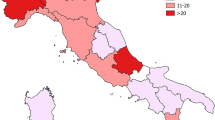Abstract
A new method to calculate lightning fatality risk is presented in order to develop a way to identify the lightning risk in areas where lightning fatality data are not available. This new method uses GIS software to multiply lightning flash density and population density on a grid and display the results on a map. A comparison to the known lightning fatality data was done to verify the method. The method works well with a quadratic regression correlation coefficient as high as 0.864, although a hybrid quadratic/log-linear regression is preferred for various reasons despite having a slightly lower correlation coefficient (0.827). Given the good performance, the lightning fatality risk method may be useful for developing countries, where lightning fatality reports may not be reliable, to help guide where to allocate scarce resources for lightning safety initiatives.








Similar content being viewed by others
References
Ashley WS, Gilson CW (2009) A reassessment of US lightning mortality. Bull Am Meteorol Soc 90:1501–1518
Cardoso I, Pinto O Jr, Pinto IRCA, Holle R (2011) A new approach to estimate the annual number of global lightning fatalities. 14th international conference on atmospheric electricity, Rio de Janeiro, Brazil
Cummins KL (2012) On the relationship between terrain variations and LLS-derived lightning parameters. 31st international conference on lightning protection, Vienna, Austria
Cummins KL, Murphy M (2009) An overview of lightning locating systems: history, techniques, and data uses, with an in-depth look at the US NLDN. IEEE Trans Electromagn Compat 51:499–518
Cummins KL., Cramer JA, Biagi CJ, Krider EP, Jerauld J, Uman MA, Rakov VA (2006) The US National Lightning Detection Network: post upgrade status. 2nd conference on meteorological applications lightning data, Atlanta, GA, American Meteorological Society
Curran EB, Holle RL, López RE (2000) Lightning casualties and damages in the United States from 1959 to 1994. J Clim 13:3449–3453
Gao Y, Zhang Y, Zhang W, Zhang Y (2014) Characteristics of lightning casualties and vulnerability evaluation regionalization in China. 5th international lightning meteorology conference, Tucson, AZ, Vaisala
Gijben M (2012) Lightning climatology of South Africa with a special focus on lightning risk maps. 4th international lightning meteorology conference, Broomfield, CO, Vaisala
Gomes C, Ab Kadir MZA (2011) A theoretical approach to estimate the annual lightning hazards on human beings. Atmos Res 101:719–725
Holle RL (2008) Annual rates of lightning fatalities by country. 2nd international lightning meteorology conference, Tucson, AZ, Vaisala
Holle RL (2009) Lightning fatalities and fatality rates by US state. International conference on lightning static electricity, Pittsfield, MA, Paper GME-3
Holle RL (2012) Recent studies of lightning safety and demographics. 4th international lightning meteorology conference, Broomfield, CO, Vaisala
Holle RL, López RE (2003) A comparison of current lightning death rates in the US with other locations and times. International conference on lightning static electricity, Paris, France, paper 103-34 KMS
NWS (2015) Natural Hazards Statistics, National Weather Service Office of Climate, Water, and Weather Services. http://www.nws.noaa.gov/om/hazstats.shtml. Update 10 June 2015
Roeder WP (2012) A statistical model for the inter-annual and intra-annual fatalities from lightning in the US and comparison to other storm phenomena. 4th international lightning meteorology conference, Broomfield, CO, Vaisala
Roeder WP, Jensenius J (2012) A new high-quality lightning fatality database for lightning safety education. 4th international lightning meteorology conference, Broomfield, CO, Vaisala
Roeder WP, Holle RL, Cooper MA, Hodanish S (2011) Communicating lightning safety effectively. 5th conference on meteorological applications lightning data, Seattle, WA, American Meteorological Society
Roeder WP, Holle RL, Cooper MA, Hodanish S (2012) Lessons learned in communicating lightning safety effectively. 4th international lightning meteorology conference, Broomfield, CO, Vaisala
Roeder WP, Cummins BH, Ashley WS, Holle RL, Cummins KL (2014) Quantifying lightning fatality risk. 32nd international conference on lightning protection, Shanghai, China
US Census (2013) www.census.gov
Valine WC, Krider EP (2002) Statistics and characteristics of cloud-to-ground lightning with multiple ground contacts. J Geophys Res 107(D20):4441. doi:10.1029/2001JD001360
Acknowledgments
The authors thank Vaisala, Inc. for use of the NLDN data and for Fig. 1. We also thank two anonymous reviewers who contributed to the improvement of this manuscript.
Author information
Authors and Affiliations
Corresponding author
Rights and permissions
About this article
Cite this article
Roeder, W.P., Cummins, B.H., Cummins, K.L. et al. Lightning fatality risk map of the contiguous United States. Nat Hazards 79, 1681–1692 (2015). https://doi.org/10.1007/s11069-015-1920-6
Received:
Accepted:
Published:
Issue Date:
DOI: https://doi.org/10.1007/s11069-015-1920-6




